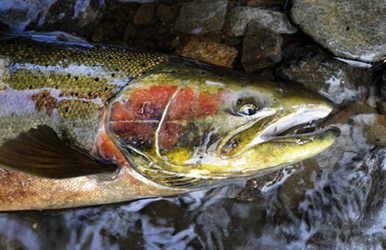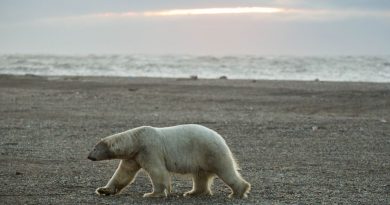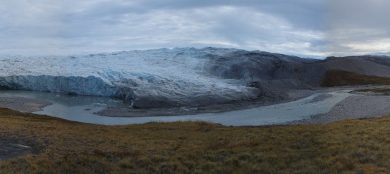Start of the Alaska fishing season snowed under in Yakutat
 As if the winter of epic snowfall wasn’t enough to suffer in coastal Alaska, now comes some really bad news: the lily white fallout is messing with the start of fishing season.
As if the winter of epic snowfall wasn’t enough to suffer in coastal Alaska, now comes some really bad news: the lily white fallout is messing with the start of fishing season.
At Yakutat on the Gulf of Alaska coast, the Alaska Department of Transportation is in an all-out war with remnants of Mother Nature’s big dump as it tries to open road access to the upper reaches of the fabled Situk River, the most renowned steelhead trout stream in the state. The fishing action on that stream usually starts the first of the month.
Not this year.
“There’s a lot of fish in the river, and nobody’s really fishing it yet,” said Bob Miller, owner of the Situk River Fly Shop. Anglers who’d scheduled trips early have canceled or rescheduled, hoping that snow blockading the river eventually melts.
12 feet of snow on road
Road crews facing 10 to 12 feet of wet, heavy compacted snow covering the road to the bridge across the upper river, some nine miles out of town, have been working almost around the clock for a week, advancing only a half-mile per day. “We haven’t had snow like this since 1974 or 1975,” said foreman Robert Lekanof.
A community of less than 700 far from the road system on a rugged, glacial, largely uninhabited coast about halfway between Anchorage and the state capital in Juneau, Yakutat has limited snow removal equipment. Lekanof said his crew of nine — the six regular DOT employees who rotate shifts to keep the airport open year-round and three reinforcements flown in from Juneau — are making do with a couple bulldozers and a couple front-end loaders.
“We are making headway,” he said. He was optimistic about reaching the so-called Nine Mile Bridge by week’s end. The snow is so deep that bulldozers are having trouble pushing it off to the sides of the road. And if they slip off the roadbed, there isn’t much to support them.
“It’s all powder underneath,” Lekanof said. “The dozers keep falling through, and once you get all the snow moved off the road, it’s like driving through a tunnel.”
Plowing and blogging
The battle to open the road has become almost a local sporting event, with Miller blogging about it most days. Nobody in Yakutat remembers anything quite like this. The community normally gets a lot of snow, but not such huge piles.
“It’s been a pretty brutal winter,” Lekanof said. “We usually get a lot of rain through the winter. We haven’t gotten any rain lately, nothing to knock (the snow) down.”
“It’s a biggie,” agreed Fran Latham, a 36-year resident and wife of a local fishing guide. “It’s piled up all over. It’s piled up 10-, 20-feet deep around our house.”
“We’re going to have snow here a long, long time,” Miller said.
Snowmachining anglers
He and the Lathams are among the local businesses that have already paid a price. “It happens,” Latham said. “We’ve been in business 40 years, so what do you expect? We’ve seen it before. In the early years, we had to rent a great big vehicle to haul the boats out” across the snow to the river.
Miller said the Yakutat Lodge is towing drift boats to the river with snowmachines this year, then hauling clients the same way. Things could be worse.
Unlike Anchorage, Yakutat did not see record snows this year, Miller said. Thanks to a couple, big, warm Gulf storms over the course of the winter, the community only got 330 inches, or 27 feet. That’s snowfall higher than the roof of the average house. “Three-hundred and 30 inches is well shy of our 405-inch record,” he said thankfully, adding, “If it had been two or three degrees colder, there would be an insane amount of snow.”
If the 34- or 35-degree temperatures that brought heavy rains in December and February had been a few degrees cooler, “then we’d really have been screwed,” Miller said.
As it is, Yakutat appears to be only half screwed. Hope remains for the fishing season in a place where tourism is a seasonal mainstay. The Situk, Miller said, appears to be getting a very strong run of steelhead. He remains confident that if there are fish, the anglers will come — no matter how much snow. He wishes they would hurry.
“We’re already down a couple thousand bucks in sales,” Miller said, “and this week is going to hurt without any cash flow.”
Still, the number of anglers showing up to fish is increasing daily, and Miller expects the season, which normally peaks April 15 to May 15, could be in full swing by the weekend. All of which could be a good thing or a bad thing. If the road to the upper river isn’t open by then, and everyone converges on the lower river, “it could be a mess,” he said.
Low water now
There aren’t a lot of good fishing holes immediately near the mouth of the river, though Miller said fitter anglers shouldn’t have that much trouble making their way upstream. The old growth forests of Sitka spruce and hemlock along the river sheltered the understory from the worst of the winter snow. There is bare ground around the base of a lot of the trees, Miller said, and only about three feet of snow between the bare spots.
And at the moment, he added, “the river is so low you can walk up the river just fine.”
That has been a plus. The low water enabled local guides with chainsaws to clear the river of trees that blew down when Yakutat was hit by hurricane force winds over the winter. It’s been a wild ride.
“It’s part of living in Alaska,” Miller said. The 49th state is an environmentally dynamic place that dishes out the good and the bad in ample doses. Low water made it easy to clear the river of blown-down trees, but now the couple of Yakutat guides with riverboats find the water too low to get far upstream with clients.
That will change as the weather warms and snowmelt flows into the river, at which point it will become much harder to walk up the river. Hopefully by then, the road to the upper bridge will be open and anglers will be able to float downstream.
The days are getting warmer, Miller said, even if the daily thaw doesn’t seem to start until 1 or 2 p.m. But there are the inevitable signs of spring in Alaska.
“The bears are actually already on the river,” he said, and “the moose are in the river. A couple years ago, we had quite a bit of snow on the banks like this and you had to kind of herd them downstream until they could finally find a place to get out.”
Contact Craig Medred at craig(at)alaskadispatch.com
For more stories from Alaska Dispatch, click here.



